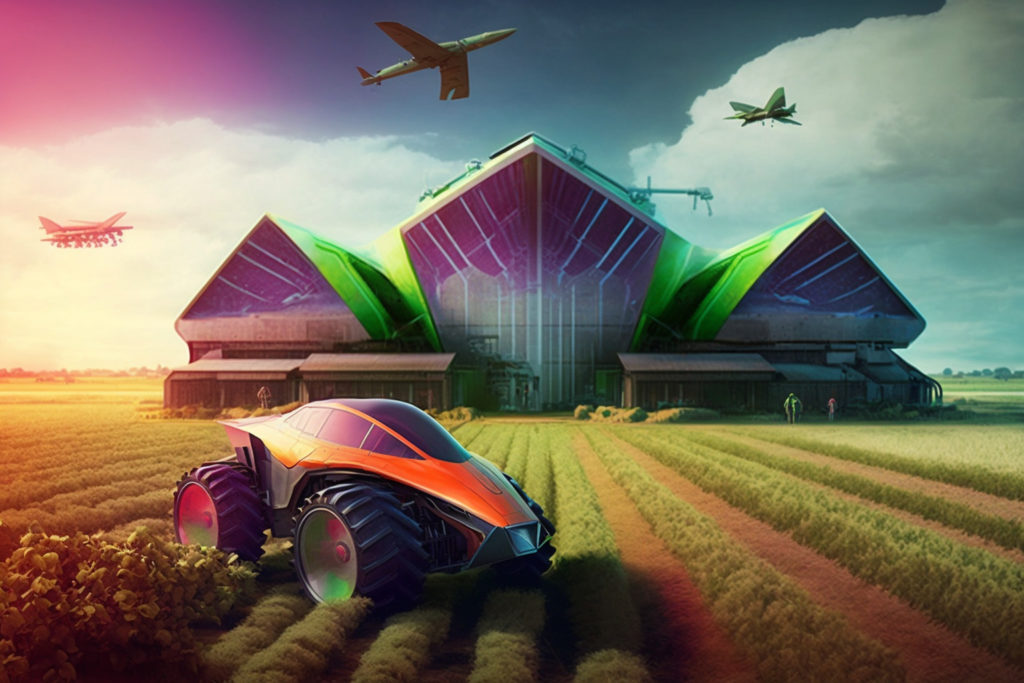I. Introduction
Agriculture is facing new challenges and opportunities in the 21st century. The increasing global demand for food, along with the need to preserve natural resources, has led to the development of new and innovative approaches to farming. One such approach is the combination of sustainable and precision agriculture, which offers numerous benefits for farmers, the environment, and consumers.
Sustainable agriculture refers to farming practices that are environmentally friendly, socially responsible, and economically viable. These practices aim to conserve natural resources, improve soil health, and reduce the impact of agriculture on the environment.
Precision agriculture, on the other hand, is a highly technological approach to farming that uses data and digital tools to optimize farming practices and improve yields. Precision agriculture involves collecting and analyzing large amounts of data from various sources to make informed decisions about planting, fertilizing, and harvesting crops.
In this article, we will explore the latest advancements in sustainable and precision agriculture, and their potential impact on the future of farming. We will examine the benefits of combining these approaches, and provide real world examples of successful sustainable and precision agriculture practices. This article is intended for market researchers and investors who are interested in the future of agriculture and the investment opportunities it presents.
II. Overview of the Sustainable Agriculture Market
The global sustainable agriculture market is poised for significant growth in the coming years, driven by increasing affordability of different sustainability approaches and the adoption of advanced technologies and the Internet of Things (IoT) in agricultural products. According to a report by PR Newswire, the market is expected to reach USD 36.24 billion by 2030, growing at a CAGR of 10.80%.
One of the key drivers of growth in the sustainable agriculture market is the increasing adoption of precision agriculture techniques, including GPS, yield mapping software (YMS), and variable rate technology (VRT). These technologies help enhance profit growth and soil fertility, while lowering farming costs and promoting sustainable agriculture practices. For example, YMS allows farmers to identify areas of their fields that require more attention, resulting in better yield and improved crop health, while VRT enables farmers to optimize fertilizer and pesticide use, reducing waste and environmental impact.
Another important area of growth in sustainable agriculture is the increasing focus on organic farming. According to a report by Yahoo Finance, key stakeholders in the organic agriculture sector are launching initiatives and projects aimed at promoting the use of sustainable farming practices. These initiatives are aimed at not only improving the quality of food, but also reducing the environmental impact of agriculture.
III. The Importance of Sustainable Agriculture
Agriculture is a critical component of our society and economy, providing food, fuel, and raw materials. However, traditional agriculture practices have a significant impact on the environment, leading to soil degradation, deforestation, and water pollution. The rise of sustainable agriculture practices has become a response to these challenges and offers numerous benefits.
A. Environmental impact of traditional agriculture
Traditional agriculture practices often involve intensive use of chemical fertilizers, pesticides, and other inputs, leading to soil degradation and water pollution. Deforestation and habitat destruction are also common practices to make room for crop production. The negative environmental impact of traditional agriculture practices has become a concern for many consumers, who are seeking more sustainable options.
B. Benefits of sustainable agriculture: increased efficiency, reduced waste, increased yields
Sustainable agriculture practices aim to minimize the negative impact on the environment and promote sustainable food production. These practices include crop rotation, conservation tillage, integrated pest management, and organic farming. Sustainable agriculture has been shown to increase efficiency, reduce waste, and increase yields, while also reducing the environmental impact of agriculture practices. For example, according to a study by the Natural Resources Defense Council, sustainable agriculture practices can increase crop yields by 50% compared to traditional methods, while reducing the use of chemical inputs by 50%.
C. Examples of sustainable agriculture practices
There are numerous examples of successful sustainable agriculture practices from around the world. For instance, organic rice production in Sri Lanka has been able to increase yields while reducing the use of harmful chemicals and improving soil health. In the United States, the US Department of Agriculture reports that the organic food industry has grown by double digits for the past decade, with organic sales reaching $49.4 billion in 2015. These examples show the potential for sustainable agriculture practices to not only improve the environment but also be economically viable.
Sustainable agriculture and organic farming practices offer numerous benefits to the environment and agriculture industry. By reducing waste, increasing efficiency, and improving yields, these practices can help to create a more sustainable and profitable agriculture industry. As consumers continue to demand more sustainable food options, sustainable agriculture and organic farming will become increasingly important components of the agriculture industry.
IV. Precision Agriculture: Improving Efficiency and Yields
Precision agriculture is a technology-driven approach to farming that aims to improve efficiency and increase yields. It is based on the concept of collecting and analyzing vast amounts of data to make informed decisions about farming practices. The goal of precision agriculture is to optimize resources, reduce waste, and improve the overall profitability of farming operations.
A. Precision Agriculture Technology and its Applications
Precision agriculture leverages a variety of technologies, such as drones, sensors, and satellite imagery, to gather data about fields, crops, and soil. This information is then used to create detailed maps and models that help farmers make informed decisions about planting, fertilizing, and irrigating crops. By using precision agriculture techniques, farmers can achieve higher yields, reduce their environmental impact, and save on inputs such as water and fertilizers.
B. Real World Data on the Impact of Precision Agriculture on Yield and Efficiency
A recent study by the US Department of Agriculture found that precision agriculture practices have increased crop yields by as much as 5-10% compared to traditional farming methods. Additionally, precision agriculture can help farmers save on inputs such as water and fertilizer, which can result in cost savings of up to 15%.
One example of the success of precision agriculture is John Deere, a leading provider of precision agriculture technology. Their precision farming solutions have helped farmers increase yields and reduce inputs, leading to improved profitability for their operations. For example, their precision planting technology has been shown to increase yields by as much as 5% compared to traditional planting methods.
C. The Future of Precision Agriculture and its Potential Impact on the Industry
As technology continues to advance, the potential impact of precision agriculture on the industry is significant. In the coming years, it is likely that we will see a further increase in the adoption of precision agriculture techniques, as farmers look to improve their efficiency and profitability. This will lead to increased innovation in the precision agriculture industry, as well as increased investment in research and development.
It is estimated that the global precision agriculture market will reach USD $15.3 billion by the end of 2023, growing at a compound annual growth rate (CAGR) of 12.3% from 2018 to 2023, according to a market research report by Market Research Future.
In conclusion, precision agriculture has already had a significant impact on the agriculture industry, and its potential for further growth and improvement is immense. As the industry continues to evolve, it is clear that precision agriculture will play an increasingly important role in the future of farming.
V. How Sustainable and Precision Agriculture Can Complement Each Other
Sustainable agriculture focuses on preserving natural resources, reducing waste, and increasing efficiency in farming practices. Precision agriculture, on the other hand, involves the use of technology and data to optimize yields and improve efficiency. By combining these two approaches, farmers can improve yields while reducing the negative impact on the environment.
For example, sustainable agriculture practices such as crop rotation, composting, and the use of cover crops can improve soil health, which is critical for optimal crop growth. Precision agriculture technologies such as soil sensors, weather monitoring, and GPS mapping can then be used to optimize irrigation, fertilization, and pest control based on the specific needs of each field. This results in a more efficient use of resources and increased yields, while also reducing the amount of waste and harmful chemicals used in farming practices.
Benefits of Combining Sustainable and Precision Approaches
There are numerous benefits of combining sustainable and precision agriculture, including:
- Improved yields: By using precision agriculture technologies, farmers can optimize crop production and increase yields. The combination of these technologies with sustainable agriculture practices can further improve yields by maintaining soil health and reducing waste.
- Reduced environmental impact: Sustainable agriculture practices reduce the negative impact of farming on the environment, while precision agriculture can further reduce waste and conserve resources by optimizing the use of inputs such as fertilizer and water.
- Increased efficiency: Precision agriculture technologies allow farmers to make informed decisions about the use of inputs, leading to a more efficient use of resources and improved yields.
Examples of Successful Combination of Sustainable and Precision Agriculture
There are many examples of successful combination of sustainable and precision agriculture around the world. One such example is the Rodale Institute, a non-profit organization that combines sustainable agriculture practices with cutting-edge technology to improve yields and reduce environmental impact. They use precision agriculture technologies such as drones and sensors to monitor crop health and optimize irrigation, while also incorporating sustainable practices such as cover cropping and crop rotation to maintain soil health.
Another example is the Fair Oaks Farms, a dairy farm in Indiana, USA that uses precision agriculture technologies to optimize their dairy production while also incorporating sustainable agriculture practices such as recycling waste and using renewable energy. This has resulted in a more efficient use of resources and improved yields, while also reducing their impact on the environment.
Examples of sustainable agriculture practices include using organic waste and residues to produce fertilizer or compost, reducing water usage through proper water sanitation and addressing water shortages, using bicycle-trailers to reduce the time required to clear land in Mozambique, and utilizing techniques to eliminate weeds that harm crops. (Social Solver).
Sustainable agriculture is not limited to small-scale, organic farms. In fact, even large-scale conventional farmers are recognizing the benefits of this approach. For example, New Seasons Market has reduced waste and improved soil quality through its sustainable agriculture practices, saving the company significant amounts of money in the process.
In conclusion, combining sustainable and precision agriculture offers numerous benefits for farmers, the environment, and consumers. By leveraging the strengths of both approaches, farmers can create a more sustainable and efficient agriculture system that improves yields, reduces waste, and conserves resources.

VI. Conclusion
Agriculture is one of the most critical industries in the world, and it is vital that it becomes sustainable and efficient to ensure its continued success. Sustainable agriculture and precision agriculture offer a comprehensive solution to the challenges facing the industry today. By incorporating sustainable practices and utilizing precision technology, farmers can reduce waste, improve efficiency, and increase yields, all while benefiting the environment.
Successful real-world examples of the combination of sustainable and precision agriculture have shown that this approach can result in remarkable gains in efficiency and yields. For instance, precision agriculture practices have been shown to increase crop yields by up to 10% while reducing waste and the use of pesticides by as much as 50%. Meanwhile, sustainable agriculture practices, such as organic farming, have demonstrated significant environmental benefits, including reduced soil erosion, improved soil health, and increased biodiversity.
The future of agriculture is bright, and sustainable and precision agriculture will play a significant role in shaping its success. Investors and market researchers should consider the potential for profitable investments in this industry and the positive impact that it can have on the world. As the demand for sustainable and efficient food production continues to grow, sustainable and precision agriculture will become increasingly important and valuable.
Bold prediction: In the next decade, we will see a significant increase in the adoption of sustainable agriculture practices, with traditional farming methods becoming obsolete. As consumers become more aware of the environmental impact of their food choices, demand for sustainably grown products will continue to rise, driving innovation and change in the agriculture industry.
In conclusion, the combination of sustainable and precision agriculture offers a comprehensive solution to the challenges facing the industry today. By embracing this approach, the agriculture industry can improve efficiency, increase yields, and benefit the environment, all while remaining profitable for investors. The future of agriculture is bright, and sustainable and precision agriculture will play a critical role in shaping its success.
Market Analysis of Interest
If you are interested in exploring more about the interplay between environmental factors and prosperity, we encourage you to read our Sustainable Manufacturing: Link between Environmental Factors and Prosperity report. Additionally, our Rising Economies in Asia-Pacific Industry Growth Forecast report sheds light on the economic prospects of the Asia-Pacific region, which could be of interest if you are interested in exploring investment opportunities.
For those interested in sustainable forestry and forest management, our Sustainable Forestry Market Report and Forest Management Guide is a must-read. The report delves into the challenges and opportunities faced by the forestry industry and provides practical advice for sustainable forest management.
Additionally, our Transportation and Beyond: How Infrastructure Impacts the Growth of the Logistics Industry report sheds light on how transportation infrastructure can impact the growth of the logistics sector, and the Unlocking the Potential of Drones: A Comprehensive Industry Report explores the exciting possibilities and challenges of using drones in various industries.
All of these reports provide valuable insights into various industries and how sustainability and environmental factors play a role in their growth and development. If you are interested in understanding more about sustainable agriculture, organic farming, and precision agriculture, these reports are sure to provide a wealth of information and context.











